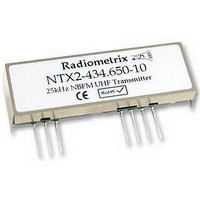NTX2-434.650-10 RADIOMETRIX, NTX2-434.650-10 Datasheet - Page 8

NTX2-434.650-10
Manufacturer Part Number
NTX2-434.650-10
Description
TRANSMITTER, 434.65MHZ, 10MW
Manufacturer
RADIOMETRIX
Datasheet
1.NRX2-434.650-10.pdf
(11 pages)
Specifications of NTX2-434.650-10
Rohs Compliant
YES
Antennas
The choice and positioning of transmitter and receiver antennas is of the utmost importance and is the
single most significant factor in determining system range. The following notes are intended to assist
the user in choosing the most effective antenna type for any given application.
Integral antennas
These are relatively inefficient compared to the larger externally-mounted types and hence tend to be
effective only over limited ranges. They do however result in physically compact equipment and for this
reason are often preferred for portable applications. Particular care is required with this type of
antenna to achieve optimum results and the following should be taken into account:
1. Nearby conducting objects such as a PCB or battery can cause detuning or screening of the antenna
2. Microprocessors and microcontrollers tend to radiate significant amounts of radio frequency hash
A simple test for interference is to monitor the receiver RSSI output voltage, which should be the same
regardless of whether the microcontroller or other logic circuitry is running or in reset.
The following types of integral antenna are in common use:
Quarter-wave whip. This consists simply of a piece of wire or rod connected to the module at one end.
At 434MHz the total length should be 164mm from module pin to antenna tip including any
interconnecting wire or tracking. Because of the length of this antenna it is almost always external to
the product casing.
Helical. This is a more compact but slightly less effective antenna formed from a coil of wire. It is very
efficient for its size, but because of its high Q it suffers badly from detuning caused by proximity to
nearby conductive objects and needs to be carefully trimmed for best performance in a given situation.
The size shown is about the maximum commonly used at 434MHz and appropriate scaling of length,
diameter and number of turns can make individual designs much smaller.
Loop. A loop of PCB track having an inside area as large as possible (minimum about 4cm
matched with 2 capacitors. Loops are relatively inefficient but have good immunity to proximity
detuning, so may be preferred in shorter range applications where high component packing density is
necessary.
Integral antenna summary:
Radiometrix Ltd.,
which severely reduces efficiency. Ideally the antenna should stick out from the top of the product
and be entirely in the clear, however this is often not desirable for practical/ergonomic reasons and
a compromise may need to be reached. If an internal antenna must be used try to keep it away from
other metal components and pay particular attention to the “hot” end (i.e. the far end) as this is
generally the most susceptible to detuning. The space around the antenna is as important as the
antenna itself.
which can cause desensitisation of the receiver if its antenna is in close proximity. The problem
becomes worse as logic speeds increase, because fast logic edges generate harmonics across the
UHF range which are then radiated effectively by the PCB tracking. In extreme cases system range
may be reduced by a factor of 5 or more. To minimise any adverse effects situate antenna and
module as far as possible from any such circuitry and keep PCB track lengths to the minimum
possible. A ground plane can be highly effective in cutting radiated interference and its use is
strongly recommended.
Ultimate performance
Ease of design set-up
Size
Immunity to proximity effects
NTX2/NRX2 data sheet
whip
***
***
**
*
helical
***
**
**
*
loop
***
**
*
*
2
), tuned and
Page 8











